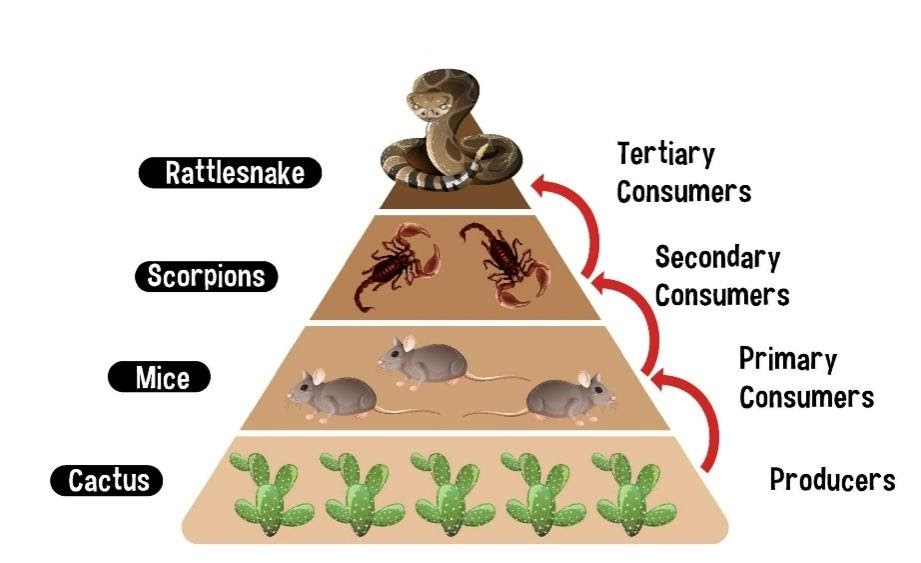
What will be the food chain of the desert ecosystem?
Answer
474k+ views
Hint: A food chain is a mode, through which energy and materials move within an ecosystem. It displays how each member of a particular ecosystem obtains its food. It is a sequence of plants, herbivores, and carnivores. Also, it constitutes a complex network of organisms. Energy is transferred from one living organism to another in the food chain. It is a linear sequence, through which nutrients are transferred.
Complete answer

Fig: Pictorial Representation of Food Chain in Desert Ecosystem
Types of deserts include dry and hot deserts, coastal deserts, cold deserts, and semi-arid deserts.
The following three lines are the food chains, exclusively observed in the desert ecosystems.
Insects $ \to $Lizard $ \to $Hawk where insect is a primary consumer, lizard is a secondary consumer and hawk is a tertiary consumer.
Rodents $ \to $Snake$ \to $ Fox where rodent is a primary consumer, snake is a secondary consumer and fox is a tertiary consumer.
Grass $ \to $ Rat $ \to $ Snake $ \to $ Eagle where grass is autotroph and remaining organisms are heterotrophs.
$ \to $ - means “eaten by”
The desert food chain starts with plants. Despite extreme heat and less rainfall, there are some animals and plants that live there. Plants perform photosynthesis and are called producers. Date palms, thorn acacia, cacti, sagebrush, desert willow, desert milkweed, desert tobacco, and some annuals. Herbivores are insects, squirrels and camels and feed on plants. Snakes, lizards, and scorpions are carnivores and feed on herbivores. Large predators include sand cat, fox, and striped hyena and some of them are omnivores and scavengers. Decomposers include bacteria, worms, and desert mushrooms decompose the dead animals and return the excreta to the soil, helping the plants to grow.
Note:
Desert ecosystems aid in the promotion of the formation and concentration of significant minerals. Potassium, nitrates, gypsum, and borates build up in deserts when water transferring the minerals evaporates. Minimal vegetation has made it easier for the extraction of significant minerals from the desert ecosystem. The largest desert in the world is the Antarctic desert, covering an area of $5.5$ million square miles.
Complete answer

Fig: Pictorial Representation of Food Chain in Desert Ecosystem
Types of deserts include dry and hot deserts, coastal deserts, cold deserts, and semi-arid deserts.
The following three lines are the food chains, exclusively observed in the desert ecosystems.
Insects $ \to $Lizard $ \to $Hawk where insect is a primary consumer, lizard is a secondary consumer and hawk is a tertiary consumer.
Rodents $ \to $Snake$ \to $ Fox where rodent is a primary consumer, snake is a secondary consumer and fox is a tertiary consumer.
Grass $ \to $ Rat $ \to $ Snake $ \to $ Eagle where grass is autotroph and remaining organisms are heterotrophs.
$ \to $ - means “eaten by”
The desert food chain starts with plants. Despite extreme heat and less rainfall, there are some animals and plants that live there. Plants perform photosynthesis and are called producers. Date palms, thorn acacia, cacti, sagebrush, desert willow, desert milkweed, desert tobacco, and some annuals. Herbivores are insects, squirrels and camels and feed on plants. Snakes, lizards, and scorpions are carnivores and feed on herbivores. Large predators include sand cat, fox, and striped hyena and some of them are omnivores and scavengers. Decomposers include bacteria, worms, and desert mushrooms decompose the dead animals and return the excreta to the soil, helping the plants to grow.
Note:
Desert ecosystems aid in the promotion of the formation and concentration of significant minerals. Potassium, nitrates, gypsum, and borates build up in deserts when water transferring the minerals evaporates. Minimal vegetation has made it easier for the extraction of significant minerals from the desert ecosystem. The largest desert in the world is the Antarctic desert, covering an area of $5.5$ million square miles.
Recently Updated Pages
Two men on either side of the cliff 90m height observe class 10 maths CBSE

Cutting of the Chinese melon means A The business and class 10 social science CBSE

Show an aquatic food chain using the following organisms class 10 biology CBSE

How is gypsum formed class 10 chemistry CBSE

If the line 3x + 4y 24 0 intersects the xaxis at t-class-10-maths-CBSE

Sugar present in DNA is A Heptose B Hexone C Tetrose class 10 biology CBSE

Trending doubts
The average rainfall in India is A 105cm B 90cm C 120cm class 10 biology CBSE

Why is there a time difference of about 5 hours between class 10 social science CBSE

What is the median of the first 10 natural numbers class 10 maths CBSE

Indias first jute mill was established in 1854 in A class 10 social science CBSE

Indias first jute mill was established in 1854 in A class 10 social science CBSE

Write a letter to the principal requesting him to grant class 10 english CBSE




